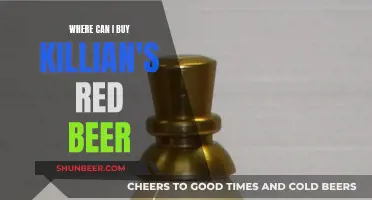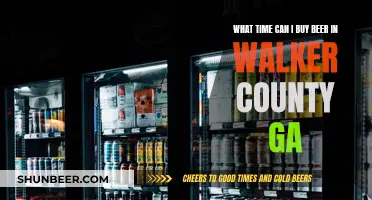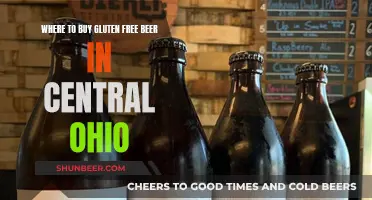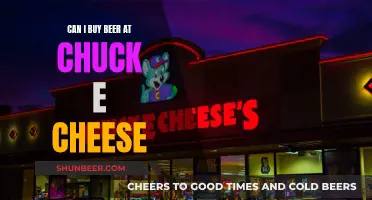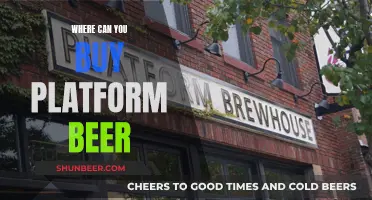
Bars, pubs, and restaurants typically purchase beer from a local beverage distributor, wholesaler, or brewery. The wholesale price is much cheaper than the retail price, allowing bars to make a profit. Distributors act as brokers between breweries and buyers, and also as wholesalers, storing beer at the brewery and only delivering it when an order is placed. Bars can also buy beer through private online liquor sales and bar and beverage ordering platforms.
How do bars buy beer?
| Characteristics | Values |
|---|---|
| Who buys beer | Bar owners, bar managers, and beverage directors |
| Where do they buy beer from | Beverage distributors, wholesalers, or directly from the brewery |
| Why do they buy from distributors/wholesalers | Wholesale prices are cheaper than retail prices, helping to increase profit margin |
| How do they buy | Phone, email, online ordering platforms, or subscription-based software |
| How much do they pay | 70-80% less than what they charge customers; small bars: $2,500-$6,000/month; mid-large: $6,000-$13,000/month |
| Markup | Average markup: 200-300%; bottles/cans of macro brew: up to 500%; craft beers: lower markup |
| Profit margin | Bottled beer: 75%; draft beer: 80% |
What You'll Learn

Buying beer from a distributor or wholesaler
Bars, pubs, and restaurants typically purchase their beer from a local beverage distributor or wholesaler, or directly from a brewery. The wholesale price is much cheaper than the retail price, helping to lower liquor costs and increase profit margins.
Bars usually pay 70% to 80% less than what they charge their customers when buying from a beverage distributor or wholesaler. Small bars tend to spend around $2,500 to $6,000 per month on alcohol, while mid- to large-sized bars can spend anywhere from $6,000 to $13,000 per month. This, of course, depends on inventory turnover and order minimums, as well as the type of bar and its location. Most bars will mark up their drinks four or five times more than the cost to cover expenses. For example, if a bar pays $1 for a single 12-ounce serving of beer, they should charge their customers between $3.33 and $5.
There are two main ways that bars can purchase their alcohol from distributors or wholesalers. The first is by contacting a sales representative by phone or online. The second is by using a bar and beverage ordering platform, where all orders are placed directly to distributors through subscription-based software. This type of software can give bar owners complete insight into vendors, order creation dates, delivery dates, and more.
When choosing a distributor or wholesaler, businesses consider not only price but also flexibility, trustworthiness, and the range of products offered. Distributors and wholesalers often supply other products such as soft drinks, wine, glassware, and other bar supplies. They may also offer different pricing levels and discount options. Fast and reliable delivery options are also important, as well as technological solutions that can improve the ordering and payment processes.
Best Places to Buy Beer in Virginia
You may want to see also

Buying beer direct from a brewery
Bars, pubs, and restaurants usually buy their beer from a local beverage distributor or brewery. Buying directly from a brewery can have its benefits, such as discounts for bulk buying and frequent ordering.
Online beer ordering
There are several online marketplaces that connect consumers with retailers and breweries, such as CraftShack, which has a wide selection of beverages and a wide distribution area. The Beer Connect is another online retailer that acts as a middleman between breweries and customers.
Shipping costs
Shipping beer is expensive. Beer bottles are heavy and fragile, so expect shipping costs to be high. Ground shipping will be cheaper but will leave your beer sitting in the heat or cold for days.
Legal considerations
The direct shipment of alcohol is largely regulated at the state level. For example, residents of Alabama, Arkansas, and Utah cannot receive beer directly and must purchase from licensed retailers in those states.
Buying in bulk
When buying from a beverage distributor or wholesaler, bars typically pay 70% to 80% less than what they charge their customers. Small bars tend to spend around $2,500 to $6,000 per month on alcohol, while mid- to large-sized bars can spend anywhere from $6,000 to $13,000 per month.
Beer Buying in Texas: Morning Restrictions and Laws
You may want to see also

How much beer costs bars
The cost of beer for bars varies depending on the type of beer and the type of establishment. The average markup on beer is about 200% to 300% when considering beer prices for bars. This is similar to restaurant wine markups, but there are more profits in the wine industry. Some bottles and cans of macro brew can be marked up to 500% because they are so cheap wholesale, whereas craft beers are quite expensive to buy wholesale, so bars don't mark them up as high. The profit margin for bottled beer is around 75%, while the profit margin for draft beer is about 80%.
The general cost-per-ounce for beer in kegs is 40 to 45% less than if it comes in cans and bottles. Therefore, the draft beer price in kegs aims for a much higher profit. The pricing strategy for draft beer is the same as canned and bottled beer: try to hit a liquor cost of 20% to 30%. However, you may want to mark up draft beer a little higher because draft beers have higher overhead expenses. Installing and maintaining draft system equipment can be quite costly, and you will also need to purchase CO2 and Nitrogen regularly to serve your beer. You'll also need to account for spillage, spoilage, and over-pouring (also known as pour cost).
Bars and restaurants can also add another layer to the mix by using different-sized glassware. As you’re targeting pour cost, consider the types of kegs you acquire and the size of drafts you sell. Both of those are levers you can use to control pour cost and achieve your target margin.
Most successful bar managers shoot for a liquor cost of 20% to 30% on their bottled and canned beer. That means if you're paying $1 wholesale for a beer bottle, it'll have a menu price of $3.35 to $5. Another method to set beer prices for bars is to use a fixed markup number for all canned and bottled beers. This adds an overhead service charge, say either 50¢ or $1, on top of the wholesale multiplier to get the menu price.
Buying Beer in Elk City, Idaho: What's the Deal?
You may want to see also

How bars price beer
Pricing beer is a tricky process. Bar owners want to set drink prices that won't drive away customers, but they also need to make a profit to grow their business. The process of setting the menu price largely depends on the specific situation.
The average markup on beer is about 200% to 300% when considering beer prices for bars. It depends on the type of beer and the type of establishment. Bottles and cans of macro brew can be marked up to 500% because they're so cheap wholesale, whereas craft beers are quite expensive to buy wholesale, so bars don't mark them up as high. The average markup is used as a guideline for setting the prices of the beer selection.
The profit margin for bottled beer should be around 75%, while the profit margin for draft beer should be about 80%. The general cost-per-ounce for beer in kegs is 40 to 45% less than if it comes in cans and bottles. Therefore, the draft beer price in kegs aims for a much higher profit. The pricing strategy for draft beer is the same as canned and bottled beer: try to hit a liquor cost of 20% to 30%.
When it comes to pricing bottled beer, most successful bar managers aim for a liquor cost of 20% to 30% on their bottled and canned beer. That means if you're paying $1 wholesale for a beer bottle, it'll have a menu price of $3.35 to $5. Another method is to use a fixed markup number for all canned and bottled beers. This adds an overhead service charge, say either 50¢ or $1, on top of the wholesale multiplier to get the menu price.
When it comes to pricing draft beer, the same concept applies as with bottled beer. First, you determine the average pour amount (usually 14.5 ounces per glass) and then divide the number of ounces in your keg by that number. If you have a ½ bbl keg with 1984 ounces, then you’ll get 136 pours. If you bought the keg for $120 and you want to have a pour cost of 20%, then your overall keg will earn $600 as each pour of 14.5 ounces would be $4.41 (or rounded to $4.50 for the sake of appearances).
The 'three times' principle is a widely followed basic pricing model in the bar and restaurant industry. "Typically, in a restaurant, you want to keep your food costs and so forth at 33 percent," says Michael Naessens, the owner of Eulogy Belgian Tavern and Bierstube, two long-established beer-centric bars in Philadelphia. "So, a lot of people simply multiply [the product cost] by 3." This approach works fine for, say, a bottle of Budweiser, which may cost a bar or restaurant in the range of 75 cents to stock. When you see bars pricing Buds for $3 apiece, this is likely the model they're using.
Cheapest Beer: Where to Buy and Save
You may want to see also

How bars increase beer sales
Bars can implement a variety of strategies to increase beer sales. Here are some effective ways to boost beer sales and enhance overall profitability:
Diverse Beer Selection:
Offer a wide range of beers, including crafts, domestics, cans, bottles, and draught options. Provide different beer styles to cater to various customer preferences, such as craft beer enthusiasts and those who prefer mainstream brands.
Beer Pairings and Flights:
Suggest tempting beer and food pairings, such as oysters with stout or fish and chips with a pale ale. Additionally, offer beer flights, which allow customers to sample a variety of beers, usually served on a tray known as a beer stick or paddle. This lets customers explore different beers and discover new favorites.
Beer Tasting Events:
Partner with local breweries to host beer tasting events at your bar. These events can attract beer lovers interested in learning about the brewing process while enjoying a night out.
Beer Cocktails:
Introduce beer cocktails, such as the Queen Mary (beer with grenadine and maraschino cherries) or the U-boot (beer with a vodka shot). These mixed drinks offer a unique twist to your beverage menu and can appeal to customers looking for something different.
Pricing Strategies:
The average markup on beer is about 200% to 300%, but it can vary depending on the type of beer and establishment. For bottled beer, aim for a profit margin of around 75%, while for draft beer, target a margin of about 80%. Adjust your pricing to cover expenses, including equipment maintenance and the cost of CO2 and nitrogen.
Marketing and Promotions:
Utilize social media platforms to promote your beer offerings, especially those popular among beer drinkers, such as Facebook and beer-focused networks. Collaborate with food and drink bloggers in your region to reach a wider audience. Create exciting promotions and events, such as beer release parties or "Paint n' Sip" nights, to attract customers and give them a reason to return.
Ambiance and Customer Experience:
Create a cozy and inviting atmosphere with lighting, decor, and music. Ensure your bar is well-lit, and consider adding signature lighting, such as dimmer lights or sconces, to enhance the ambiance. Use accent lighting to showcase your beer bottles and art pieces. Music can also influence sales, with upbeat music increasing sales during busy periods, and slower music creating a relaxed atmosphere during quieter times.
Staff Interactions:
Encourage bartenders to interact with customers regularly, as studies show that staff interactions every 30 minutes can increase alcohol sales by up to 30%. Train your staff to be friendly, attentive, and knowledgeable about the drinks they are serving.
Upselling:
Upselling can increase bar revenue by up to 60%. Train your bartenders to suggest upgrades or complementary items, such as appetizers or desserts, to increase the average spend per customer.
Signature Scents:
Add signature fragrances or diffusers to your bar to create a pleasant and inviting atmosphere. Research has shown that customers increase alcohol purchases by 27% when they have a positive experience, and scent can play a subtle yet powerful role in enhancing their overall experience.
By implementing these strategies, bars can effectively increase beer sales, improve customer satisfaction, and maximize their profitability.
Best Places to Buy Ultra Light Beer
You may want to see also
Frequently asked questions
Bars typically purchase beer from a local beverage distributor or a brewery.
They can either contact a sales representative for a distributor or wholesaler directly or use a bar and beverage ordering platform, where orders are placed directly to distributors through subscription-based software.
Bars pay around 70% to 80% less than what they charge their customers. Small bars tend to spend around $2,500 to $6,000 per month on alcohol, while mid- to large-sized bars can spend anywhere from $6,000 to $13,000 per month.
The average markup on beer is about 200% to 300%, but this depends on the type of beer and the type of establishment. The profit margin for bottled beer should be around 75%, while the profit margin for draft beer should be about 80%.


